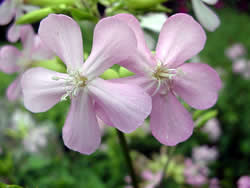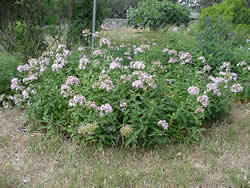Search
For The Answer
Click here to access our database of
Plant Answers
Search
For The Picture
Click here to access the Google database of plants
and insects
Information
Index
Alphabetical Listing of Topics, Recommendations
and Plants
Milberger's Nursery and Landscaping
3920 North Loop 1604 E.
San Antonio, TX 78247
210.497.3760
nursery@milbergersa.com
Open 9 to 6 Mon. through Sat.
and 10 to 5 on Sun.

Three exits east of 281, inside of 1604
Next to the Diamond Shamrock station
Please click map for more detailed map and driving directions.


BOUNCING BET-- A DEER RESISTANT, EVERGREEN
BLOOMING GROUNDCOVER
this Saponaria officinalis SOAPWORT Family: Carophyllaceae Zone 7 Height: 1 foot tall until flowering, then 2 feet or more Bloom: Summer bloomer Bouncing Bet is an interesting perennial that is well adapted
to most of S. officinalis has long been used as a cleansing agent, for in
addition
The plants are resistant to insects and diseases. It tolerates dry or rather wet growing conditions. Bouncing Bet is native to Europe and Asia but is reported to have naturalized in North America. ============================= Saponaria officinalis; Family name: Caryophyllaceae Common name(s): Bouncing bet, Soapwort While this species' pink flowers on their 24 in (60 cm) tall
stems are Hardiness zone from 5 To 10; Plant Height approx. 60 cm; Flowering colors: Pink; Garden type: Dry Garden, Rockery/Bank, Small Garden; Position: Partial Sun to Shade Cultivation is easy, as plants are tolerant of poor soils--wet or dry; Roots have been used medicinally and juice can be used for forming a lather with water. It has dark green leaves. Loose clusters of inch-wide summer flowers in red, pink, or white. Roots crushed in water produce a sudsy, detergent-like lather. This is a tough plant; before the days of herbicides, it could be seen growing in the cinders along railroad rights-of-way. From Poisonous Plants of North Carolina: Poisonous Part: Roots and seeds. Severity: CAUSES ONLY LOW TOXICITY IF EATEN. =================================== Saponaria officinalis L. Family - Cayophyllaceae Stems - Single or multiple from base, erect, herbaceous, from
a taproot Leaves - Opposite or in whorls of 3 or 4, sessile, connected
at bases by Inflorescence - Terminal and axillary cymes. Peduncles slightly
swollen Flowers - Petals 5, long-clawed, white to pink. Claw to +1.5cm
long, Flowering - June - October. Habitat - Gravel and sand bars along streams, ditches, waste
ground, Origin - Native to Europe. Other info. - This species can be found throughout Missouri.
It was This species contains saponin glycosides and will foam if crushed
and |



